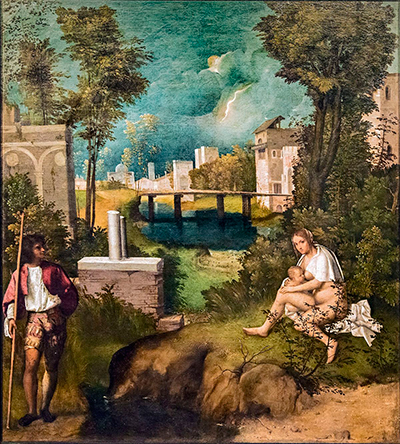Most probably commissioned by wealthy Venetian, Gabriele Vendramin c.1506, The Tempest is widely considered to be the earliest example of landscape painting in western art.
It beautifully illustrates the mastery of colour, tone and blended light which was indicative of the work produced by Giorgione and the Venetian School. Housed today in the Gallerie dell'Accademia of Venice in Italy, the subject and meaning of The Tempest has been debated for centuries, and it remains one of Giorgione’s most enigmatic works.
Giorgio Barbarelli da Castelfranco or Giorgione as he was better known, was born c.1477 in Venice, but tragically died of the plague in his early thirties. Consequently, we are left with too few of his wonderful works. In fact, The Tempest is one of only six paintings which can be definitively accredited to Giorgione due to lack of documentation. Nonetheless, the small body of work that he has left proves him to be one of the greatest artistic geniuses Italy ever produced.
The painting describes two figures; on the right, a nursing mother and on the left a young man with a staff. The pair are apparently on the outskirts of a city, separated by a stream. As the title would suggest, there is an impending storm overhead and there is even an indication of lightning in the gathering clouds.
The woman in the picture is naked, sitting under a tree while she nurses her son at an awkward angle exposing her person. She appears to be being watched by a young man who is walking along a road on the other side of the stream. The man is fashionably dressed and has been described as a gypsy, a soldier and even by some scholars as perhaps Giorgione himself.
The town in the background of the painting, which some suggest my depict Padua, appears to be in danger, but the couple seem to be quite oblivious. They also appear to pay no attention to the gathering and ominous storm described so perfectly by Giorgione in a subtle blue and green palette and softening techniques. The composition of the work has two distinct halves; the foreground and the backdrop of the city. The pastoral scene depicted in the front is so clearly rendered that it is obviously fashioned from nature, while the city scape is generic and could be from memory.
The depth of feeling evident in The Tempest was almost unprecedented at the time. This new style of applying the paint to the canvas took the art world by storm and inspires artists to this day. Giorgione was a student of Venetian master, Giovani Bellini, and along with Titian was a founding member of the Venetian School which was one of the most influential groups of the high renaissance. They developed a manner of softening and blending colours and tones similar to Da Vinci’s sfumato, which allowed for greater expression of feelings and mood within their paintings. This emotional depth was clearly inspired by the humanist movement which informed the works of so many artists earlier in the renaissance, and a stark contrast to the more linear and structured Florentine School.
The meaning of The Tempest has long been a subject of great debate. Indeed, it appears to contain so many contradictions and complexities, that renowned biographer Giorgio Vasari was quoted as saying the he "never understood The Tempest". Debating the meanings and hidden subtleties of the painting seems almost counter intuitive, as the Venetian School’s reason for being was the expression of emotion and feeling and not about the intellectualisation of their work. The enigma of the subject matter would almost seem the very point.
However, Giorgione himself, was renowned for hiding meaning and symbols within his paintings, so it may be worth examining. Scholars have suggested that the painting may, in fact, be a vision of the garden of Eden with the figure symbolising Adam and Eve with her son; the coming storm indicating the wrath of God and their impending banishment. However, following x-ray examination, it was discovered that the male figure was originally an additional female nude, so this interpretation would seem unlikely. Perhaps a more compelling argument, considering the political unrest of the time, could have been a warning regarding the growing likelihood of war between the City of Venice and the League of Cambria (an organisation directed by the Pope Julius II). The fact that the figures seem unaffected by the storm would suggest that the City of Venice is unaware of what it may lose if it came to war with the church.
Of course, there are also critics who believe that the story behind The Tempest is biblical in nature, perhaps depicting the flight from Egypt or merely a vision of heaven. Art critics will, no doubt, continue to debate Giorgione’s intentions when he created this seminal work, but the truth is that its mystery is a large part of its charm and allure. The artist himself may have simply created a beautiful scene for the joy of painting it. Whatever the meaning, “The Tempest” remains one of our great artistic treasures, both for its breath-taking beauty and the possibilities it conjures in the mind.




